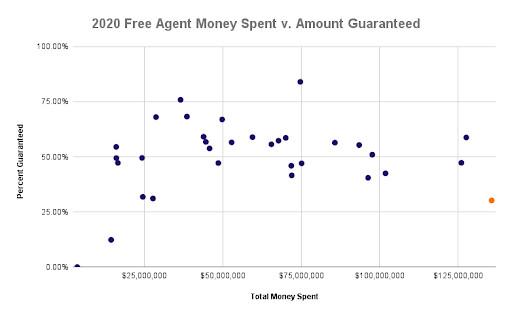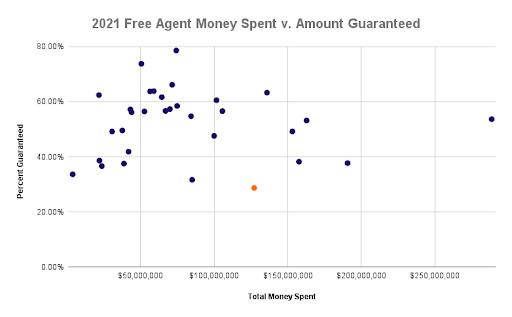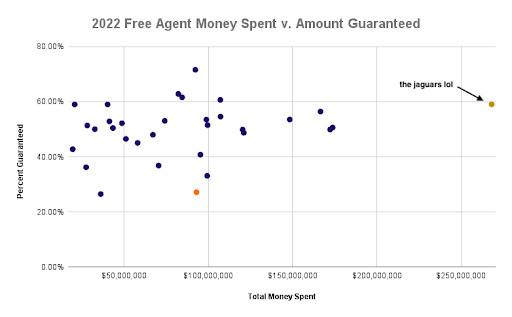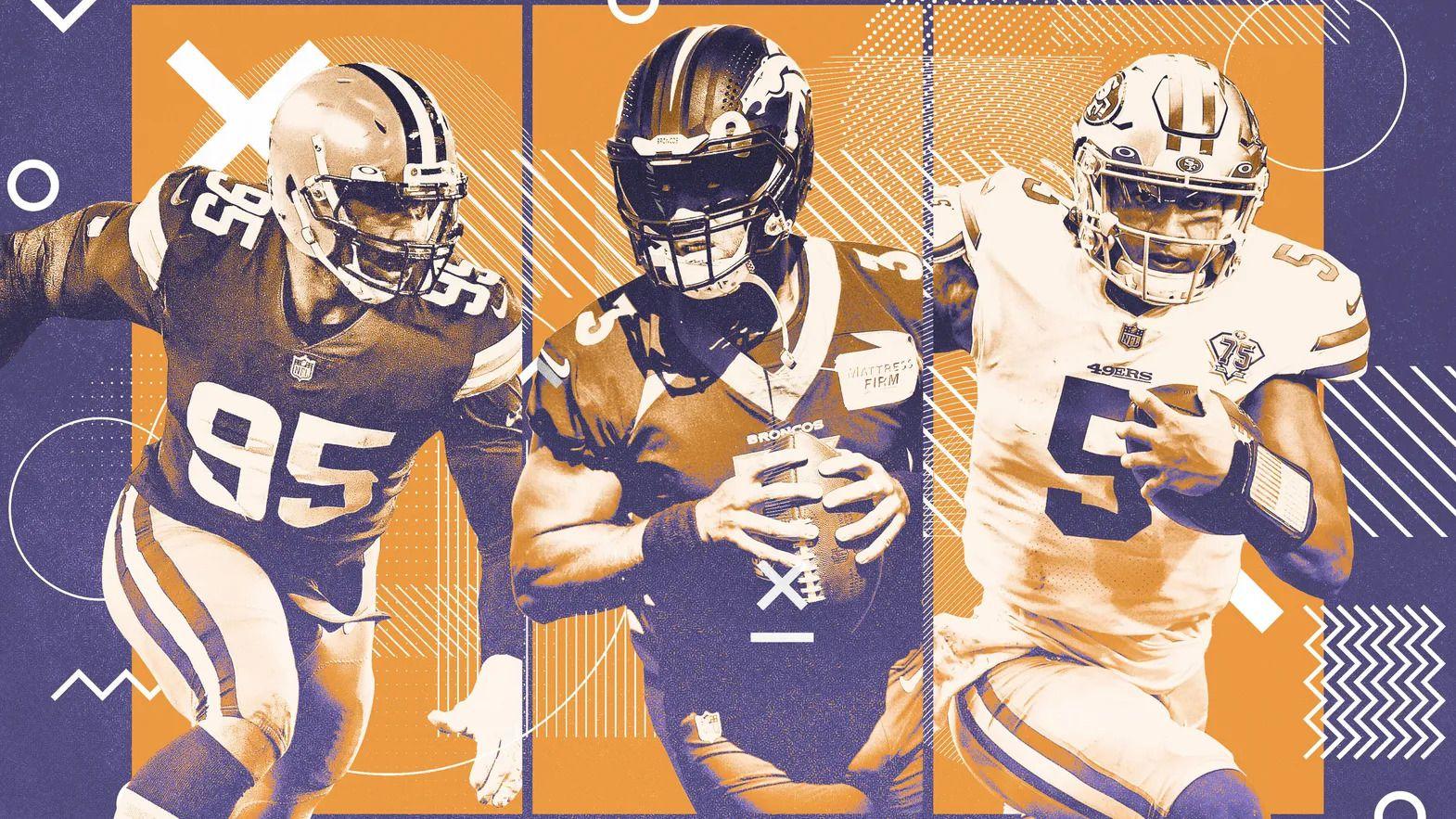NFL teams have spent the past six months reshaping their rosters and now, finally, the 2022 regular season is nearly upon us. But which teams have truly pushed all their pieces to the middle of the table and are ready to make a serious run to Super Bowl LVII? Welcome to The Ringer’s All In Week, where we’ll examine the quarterback moves, team-building philosophies, and gambles that teams have made to compete for a championship and determine what it truly means to be all in.
In The Ringer’s 2022 All In-dex, it does not take much effort to find the Super Bowl champion Los Angeles Rams. They are at the top of the list—the most all in of the all-in teams. They’ve traded most of their future picks, spent a ton of money, built a juggernaut, yadda yadda yadda. You already know their story.
It takes a little longer to find the Super Bowl runner-up: the Cincinnati Bengals. They are dead average: 16th overall, with a spending rank lower than all but six teams. A team only months removed from a Super Bowl appearance should be spending more money—that’s how you get there again! But while teams like the Rams, Bills, Chargers, Buccaneers, and Packers throw money around in an effort to build contenders, the Bengals sink to league bottom with the Bears, Falcons, Texans, and Giants. Oddsmakers and sports bettors see this and wonder just how seriously to take the Bengals: At +2080, the Bengals have the longest odds to win the Super Bowl of any runner-up since the 2009 Cardinals.
To be fair to the Bengals, their low spending is a bit misleading. When you draft well at premium positions, you will spend less money than other teams, who have been forced to sign big contracts to acquire such players. And the Bengals drafted virtually their entire offense. Quarterback Joe Burrow and wide receiver Tee Higgins were selected in the first and second rounds of the 2020 draft, and receiver Ja’Marr Chase was grabbed one year later. With those three as stars of the offense, no team in the league has a cheaper, contending-caliber nucleus for their passing game. Tyler Boyd, the third pass-catching option, is actually the most expensive player for that unit, with the 15th-highest cap hit among NFL receivers this season. Chase is 24th, and Higgins is all the way down at 74th. And Burrow? His cap hit is 18th among quarterbacks, just above fellow early first-round picks Daniel Jones, Trevor Lawrence, and Tua Tagovailoa—all of whom play for teams unlikely to contend.
The extra money afforded by cheap contracts at quarterback and receiver defines the 2022 Bengals. Some contenders have productive rookie-contract players at one of those two positions—only the Bengals have them at both. Of the 13 teams expected to start a quarterback with a rookie contract this season, only Burrow, Zach Wilson, and Justin Fields will throw to two primary targets each with their own rookie contract. The Bears and the Jets each have Super Bowl odds of +13600 or more—an implied probability of less than a 1 percent chance. Neither of those teams is trying to win a Super Bowl, and nobody thinks they should be, either. Their lack of all-inness is justifiable. But the Bengals have a golden opportunity right now. Why aren’t they trying harder?
The Bengals are trying. They were aggressive in free agency across the past few offseasons—not just by Cincinnati standards, but by league standards, as well. Last offseason, the Bengals let homegrown talent Carl Lawson walk and replaced him with big-money free agent Trey Hendrickson. They bolstered their cornerback room by signing Chidobe Awuzie and Mike Hilton, having failed to remedy the position the year previous with a big contract for Trae Waynes. D.J. Reader was the 2020 free-agent pickup at defensive tackle; Larry Ogunjobi was the pickup in 2021. The Bengals were seventh in money spent during the 2021 free agency period and first in 2020, after four straight seasons in which they were bottom-five in spending.
All of this work got the Bengals to the Super Bowl—but of course, getting to the Super Bowl isn’t the ultimate prize. Winning it is—and you don’t get a second trophy if you win it while spending less money than the other guys. The Super Bowl loss should have prompted the Bengals to push the chips in this offseason. But their spending was only modest—14th overall by total money spent. The Bengals signed Ted Karras, Alex Cappa, and La’el Collins along the offensive line—critical additions to improve the weakest positional group left on their roster—but added almost no one else of note to the roster. Most notably, they did not extend star safety Jessie Bates III, who held out for most of camp after being given the franchise tag, before finally reporting earlier this week.
“I don’t think that’s my question to answer,” Bates said this week when asked why he wasn’t next in line among Bengals players to get an extension. “I’m not sure why I’m not paid yet.”
It does seem a little peculiar. If the story started at Bates’s asking price and ended at the Bengals’ cap space, he would have been paid months ago—even with how much safeties have been getting paid lately. Five safeties now make more than $15 million per season, and all of those deals have been signed in the past 18 months—Bates almost certainly wants a figure in that range, and deservedly so.
It’s unlikely the price tag is the hang-up. We know that the Bengals are willing to pay players at market rates. They gave Hendrickson a deal worth $15 million per year, equal to the figure that Lawson got from the Jets, and right in line with Matt Judon ($13.6 million per year) and Leonard Floyd ($16 million per year) as primary pass rushers on their respective teams. They just gave B.J. Hill $10 million per season, which is top-20 money among defensive tackles. La’el Collins ($7 million) is top 10 among right tackles, Alex Cappa ($8.75 million) is top 15 among guards, and Ted Karras ($6 million) is top 15 among centers.
The issue isn’t the money. It’s the guaranteed money.
Let’s take Karras’s deal. Karras is due $18 million over the next three years, but with only a $3 million signing bonus and $2 million roster bonus due in 2022, Karras has just $5 million in guaranteed money. Brian Allen, the center for the Rams who also signed a three-year, $18 million deal in free agency this offseason, has $10 million guaranteed. You can do this with just about anyone. Cappa is making $8.75 million for each of the next four years, but has only $11 million in total guarantees on his deal; Austin Corbett, a guard signed by the Panthers this year, is making $8.75 million for each of the next three years, and has $19.6 million in guarantees. Collins is an unfair comparison, given his late free-agent process and tricky health situation, but B.J. Hill? He signed a three-year, $30 million deal, similar to what Foley Fatukasi got from the Jaguars. But Hill has $13 million in guaranteed money, while Fatukasi has $20 million guaranteed.
Just 43 percent of Hill’s total money is guaranteed. Among defensive tackles making at least $10 million, only two have a lesser fraction of their contract guaranteed: Cameron Heyward (40 percent) and another Bengal (!), D.J. Reader, at 38 percent. Yet Hill’s guarantees represent one of the largest guaranteed commitments the Bengals have made during their spending spree. Here are the current Bengals whom the team signed in free agency, ranked by the percent of the deal that is guaranteed.
Recent Bengals Free Agent Signings
Now, all of the money the Bengals have spent in the past few free agency carousels takes on a different light. They’re handing out more contracts than ever before—but they still aren’t guaranteeing any money. In 2020, when they handed out more total contract value than anyone else, they guaranteed only around 30 percent of the money spent. The only two teams that had lower numbers spent almost nothing:

In 2021, the Bengals were dead last in the percentage of guaranteed free agency money:

And again in 2022, they were near the bottom:

This brings us back to Bates. Put the $15 million yearly figure aside and look at guaranteed money. The highest-paid safety with less than 40 percent of their contract guaranteed is D.J. Reed, who has 32 percent of his three-year, $33 million deal guaranteed; next is Adrian Amos, with 33.3 percent of a four-year, $36 million deal guaranteed. These are not analogous contracts from which Bates’s contract can be modeled—Bates is making $12.9 million with the franchise tag, so deals averaging $11 million and $9 million per year are of no interest to him. For top contracts, guaranteed figures are much larger: Derwin James Jr., Jamal Adams, and Marcus Williams all got more than 50 percent of their deals guaranteed when they signed in the past two offseasons; Minkah Fitpatrick and Harrison Smith cleared 40 percent.
This is likely why Bates isn’t signed. The guaranteed figures at the top of the safety market are growing out of the Bengals’ range. Escalating guarantees aren’t tricky to sidestep for B-tier free agents like Hendrickson, Hill, Cappa, and Awuzie, but for an A-tier player like Bates, it’s almost impossible for contract negotiations to find a happy medium. The chasm of guarantees is too difficult to cross.
Currently, this is an issue only at a premium position like safety, which has seen huge leaps in contract value over the past few offseasons. The Bengals have Joe Mixon, who’s tied for the sixth-highest-paid running back, but could still give him a big contract without heavy guarantees (only 21 percent of the deal is guaranteed money) because the running back market isn’t nearly as competitive. In Mixon, the Bengals were able to pay a homegrown star.
But the Bengals’ next homegrown stars don’t play running back. They play quarterback and wide receiver. And those are the most competitive positional markets in the league.
Burrow and Chase define the Bengals’ title window. Their star talent makes the Bengals one of the league’s most exciting teams to watch, and their rookie contracts make the team one of the league’s most exciting to fantasize about. All that talent, with all that cap space? It’s a dream come true.
But it’s just a dream. Reality is a lot harsher.
The Bengals have plenty of cap space, but they don’t have a lot of cash. Actual, honest-to-goodness cash. Forbes ranked the Bengals dead last in total team value at $3 billion, a whole $5 billion less than the Cowboys, who topped the list; Mike Brown, the Bengals’ owner, has a net worth of $925 million—only Mark Davis of the Raiders is lower on the list.
Cap space is needed to sign contracts, but actual cash must be on hand to pay those contracts—and when it comes to guaranteed money, that cash needs to be on hand now. The NFL’s funding rule requires that team owners place into escrow the guaranteed money on the future years of contracts already signed. For example, in the case of the Deshaun Watson contract—a massive, fully guaranteed deal that will have ramifications in the quarterback market for years to come—the Haslam family must place a whopping $169 million in escrow, set aside as the money that Watson is guaranteed to (eventually) make in the upcoming years of his deal.
The Bengals didn’t have to extend Burrow this offseason—they technically don’t have to extend him until the 2025 offseason, after the remaining two seasons of his deal and the fifth-year option. But when it comes time for Burrow to get paid, Burrow is going to get paid. The Brown family will need to put nine figures of money into escrow, and that is going to be a challenge. They’re also going to need to pay Higgins and Chase—and while wide receivers aren’t signing fully guaranteed deals (yet), they’re still signing for over $50 million in total guarantees. Those numbers start to add up.
It’s easy to look at the Bengals and wish they were spending more. But the Bengals have a longer view. As Mike Brown said this past summer, “Our whole focus is going to be on keeping [Burrow] here. … We see the train coming.”
In this light, we no longer just see B.J. Hill’s extension and Bates’s contract dispute. Now we see the Bengals’ stadium name, which had long belonged to Brown’s father, Paul, sold to Paycor HCM, in a move that Brown said his father “would have agreed to” because he “was always for what is best for the football team.” We see a new health care sponsor with naming rights to the Bengals’ practice field. The Bengals have new uniforms and a new Ring of Honor. Elizabeth Blackburn, Mike Brown’s granddaughter, created the role of director of strategy and engagement and spearheaded many of these changes, while also emphasizing the internal content and social teams within the organization. The Bengals have their stars, and they have the cap space to pay them. Now they need to make a bunch of money.
The Bengals are no longer just signing contracts with low guarantees because that’s the best way for them to do business—it’s the only way they can do business. When the Bengals extended Andy Dalton and Carson Palmer in previous eras of quarterback contracts, they could get away with guarantees built only into signing and roster bonuses—no guaranteed salary. We live in a different world now. The Bengals are about to sign a deal unlike any deal they’ve ever signed.
Widen the scope, and suddenly, the Bengals are all in. They know what they need to compete every year—Joe Burrow—and they know what it takes to keep him here forever: years of careful planning and accounting. To go all in now by luring star free agents with big contracts and losing future, cheap deals by trading picks for players might feel nice, but not if it precludes them from making the grander moves they need in the future. It’s a honeytrap they must avoid.
“Going all in” is an easy phrase to throw around. It’s been integrated into the lexicon of team-building, so assimilated to the point that it demands no attention. It means “this team is building aggressively to try to win a Super Bowl.” But it’s important to remember: It’s poker players that go all in, and when they do, they risk being eliminated from the game. Were the Bengals to go all in now, they’d risk elimination from the Joe Burrow contract sweepstakes in a few years—and that isn’t a risk they’re willing to take.
Perhaps here then, another piece of poker lingo is better: a rebuy. When a player rebuys, they spend their own money to purchase more chips, increasing their stack size at the table and allowing them to keep playing the games. The Bengals aren’t going all in—not just yet. They’re rebuying. They’re building their stack. They want to play this game, and if they play it right, they’ll have Burrow—and the possibility of contention—for years to come.
